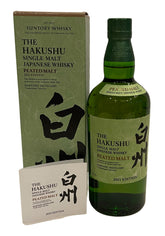The Art of Whisky Tasting: How to Develop Your Palate

Whisky, with its complex flavors and aromatic richness, is a spirit that offers an exciting journey for those willing to explore it deeply. Whether you're a casual sipper or a budding enthusiast, learning the art of whisky tasting can significantly enhance your appreciation of the drink. But how do you develop your palate to truly experience the full range of flavors whisky has to offer? In this article, we'll dive into the key steps of whisky tasting and share tips to refine your ability to distinguish the subtle nuances that make each whisky unique.
1. Understanding the Basics: What Is Whisky Tasting?
Whisky tasting is more than just taking a sip and enjoying the warmth as it goes down. It’s about engaging your senses — sight, smell, taste, and even touch — to unlock the different flavors and characteristics present in the whisky. Each whisky is a product of its ingredients, production methods, and maturation process, meaning that no two whiskies are exactly alike.
While professional whisky tasters may detect dozens of aromas and flavors in a single dram, don’t be intimidated! Whisky tasting is a skill you can develop over time, and the more you practice, the more perceptive your palate will become.
2. The Whisky Tasting Process: Step-by-Step
Step 1: Observe the Color
Before you even take a sip, start by observing the whisky’s color. Pour the whisky into a clear glass and hold it up to the light. The color of the whisky can give you clues about its age and the type of cask it was matured in. For example:
- A deep amber color often indicates long maturation in oak barrels, possibly sherry casks.
- A pale golden color may suggest the whisky has spent less time aging or has been matured in bourbon barrels.
While color alone won’t tell you everything about the whisky, it’s the first step in getting to know the liquid in your glass.
Step 2: Smell the Whisky (The Nose)
Next, take a moment to breathe in the whisky’s aroma. This is referred to as "nosing" the whisky. Swirl the glass gently to release more of the aromas, then take a few small sniffs, holding the glass a few inches from your nose. When nosing, you’re not just smelling alcohol — you’re detecting layers of scent that come from the whisky’s ingredients, fermentation, and aging process.
Common aromas include:
- Fruity notes like apple, pear, or citrus.
- Spicy hints like cinnamon, nutmeg, or pepper.
- Sweet aromas like vanilla, honey, or caramel.
- Smoky or peaty elements, especially in Scotch whisky.
Step 3: Taste the Whisky (The Palate)
Now comes the most exciting part — tasting the whisky. Take a small sip and let it sit on your tongue for a few seconds before swallowing. Pay attention to how the flavors evolve in your mouth. Whisky has a beginning, middle, and finish, and each phase may reveal different flavor notes.
Some common flavors you might detect include:
- Fruity: Think dried fruits like raisins or fresh fruits like apples and peaches.
- Woody: This can come from the barrels used in aging, with oak, cedar, or even charred wood notes.
- Smoky or Peaty: Certain whiskies, especially those from Islay in Scotland, may have a smoky or earthy taste from the use of peat during the malting process.
- Sweet or Spicy: You might taste sweet elements like toffee, honey, or maple syrup, as well as spices like cloves, pepper, or anise.
Step 4: The Finish
The finish refers to the lingering taste and sensation after you swallow the whisky. A good whisky will have a long, complex finish that leaves a lasting impression on your palate. Some whiskies may leave a warming sensation, while others may have a dry, peppery, or even fruity finish. Take note of how long the flavors persist and what sensations remain.
3. Tips to Develop Your Whisky Palate
Now that you know the process, how can you refine your palate to become a more skilled whisky taster? Here are a few tips:
1. Take Your Time
Whisky tasting is not a race. Give yourself time to savor each sip and fully engage with the flavors and aromas. The more you practice mindful tasting, the more sensitive your palate will become.
2. Try Different Types of Whisky
To develop your palate, it’s important to taste whiskies from different regions and styles. Scottish single malts, Irish whiskeys, Japanese whiskies, and American bourbons all have distinct characteristics. Comparing them will help you identify regional signatures and flavor profiles.
3. Use a Whisky Tasting Wheel
A whisky tasting wheel is a useful tool that can help you identify flavors and aromas. It categorizes common whisky flavors (fruity, woody, spicy, smoky, etc.) and breaks them down into subcategories. As you taste whisky, refer to the wheel to see if any of the descriptors match what you’re experiencing.
4. Take Notes
 Keep a whisky tasting journal where you can jot down your observations about each whisky you try. Write down the whisky’s name, region, age, and tasting notes (color, nose, palate, finish). This will help you track your progress and compare whiskies over time.
Keep a whisky tasting journal where you can jot down your observations about each whisky you try. Write down the whisky’s name, region, age, and tasting notes (color, nose, palate, finish). This will help you track your progress and compare whiskies over time.
5. Compare and Contrast
Host or attend whisky tastings where you sample different whiskies side by side. By comparing two or more whiskies in one session, you’ll be better able to distinguish subtle differences in flavor and texture.
6. Don’t Be Afraid to Experiment
Everyone’s palate is different, so don’t be discouraged if you don’t detect the same flavors as others. With practice, you’ll learn what you like and develop your own tasting style.
4. Conclusion: The Journey of Whisky Tasting
Developing your whisky palate is an enjoyable and rewarding process. It’s not about getting it “right” but about exploring and savoring each unique whisky experience. The more you practice, the more you'll uncover the intricate layers of flavor that make whisky such a remarkable spirit. So, grab a glass, start nosing and tasting, and embark on your own whisky-tasting journey!




